Mudéjar Architecture of Aragon: The Mudéjar architecture can only be found on the Iberian Peninsula. The Mudéjar architecture is the result from Christian and Muslim cultures living side by side. In 711, Arab rulers conquered most of the Iberian Peninsula, they remained in control over large parts of Spain and Portugal for almost 800 years. They brought their culture and exerted a strong influence on Spanish architecture. The Mudéjar architecture developed from the 12th century until the 16th century. The Mudéjar style is characterised by the use of brick as the main material, adorned with tilework, wood carving, plaster carving and ornamental metals. The Mudéjar style reached his peak in the city of Teruel in Spain. During the 13th, 14th and 15th centuries, many Mudéjar towers and churches were built in Teruel. Other important Mudéjar architecture can be found in Toledo and Zaragoza. The Mudéjar architecture of Aragon gained the status as a UNESCO World Heritage in 1986.
www.werelderfgoedfotos.nl © Copyright World Heritage Photos
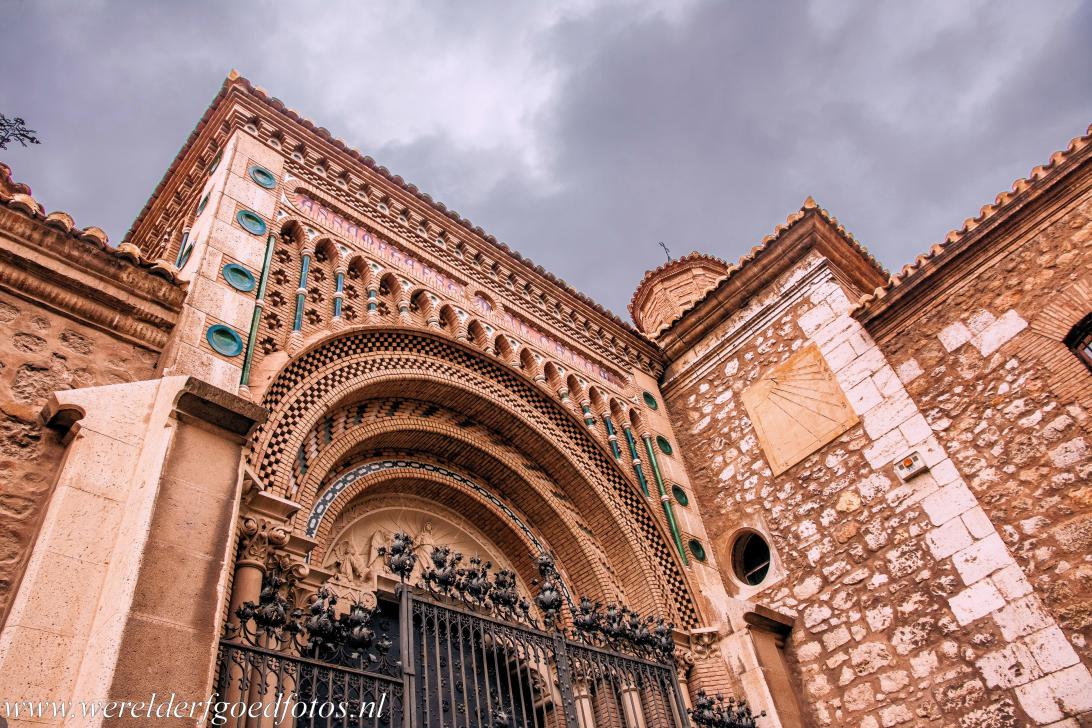
Mudéjar Architecture of Aragon: Teruel Cathedral, the Catedral de Santa María de Mediavilla. In 711, Arab rulers conquered Spain and remained in control over large parts of Spain for almost 800 years. The Arabs brought their culture and architecture. Mudéjar were muslims who were allowed to remain in Spain after the Reconquista. They strongly influenced the architecture of Spain. The Mudéjar Architecture of Aragon was declared a UNESCO World Heritage in 1986.

Mudéjar Architecture of Aragon: Teruel Cathedral, the Catedral de Santa María de Mediavilla. In 711, Arab rulers conquered Spain and remained in control over large parts of Spain for almost 800 years. The Arabs brought their culture and architecture. Mudéjar were muslims who were allowed to remain in Spain after the Reconquista. They strongly influenced the architecture of Spain. The Mudéjar Architecture of Aragon was declared a UNESCO World Heritage in 1986.
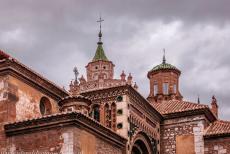
Mudéjar Architecture of Aragon: Teruel Cathedral or the Catedral de Santa Maíia de Mediavilla. Teruel Cathedral has one of the best preserved Mudéjar bell towers in Spain. The Mudéjar style is characterised by the use of brick as the main building material, adorned with wood carving, plaster carving, tilework and ornamental metals. Teruel Cathedral is one of the most important examples of the Mudéjar architecture.
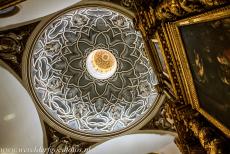
Mudéjar Architecture of Aragon: The Mudéjar dome of the Cathedral of Teruel, the Santa Maria de Mediavilla. The Santa Maria de Mediavilla was built in 1171-1578. The dome was constructed in 1538. The 14th century ceiling of the nave features a series of sunken panels in the shape of a square, known as coffers, decorated with small images of religious, historic, human and animal figures in the Gothic style.
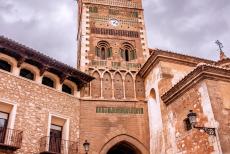
Mudéjar Architecture of Aragon: The bell tower of Teruel Cathedral is one of the best preserved Mudéjar towers in Spain and also one of the oldest. The tower was erected in the 13th century. The Iglesia de Santa María de Mediavilla was converted into the Teruel Cathedral in 1587, it is known as the Catedral de Santa María de Mediavilla. A footpath passes through a gate in the lower part of the tower. The cathedral is one of the most important Mudéjar buildings in Teruel.
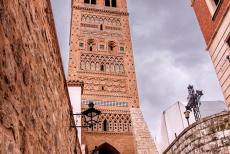
Mudéjar Architecture of Aragon: The Torre de San Martín in Teruel was built in the Aragonese Mudéjar style in 1315 and 1316, the road passes through the pointed arch, the tower has three storeys. Like many other towers in Teruel, the Torre de San Martín, St. Martin's Tower, is a city gate. The tower is decorated with ceramic glaze and brick ornaments. The Torre de San Martín in Teruel was named after the adjoined Church of St. Martin.
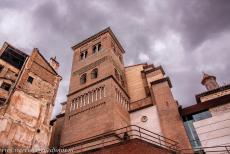
The San Pedro Tower and the San Pedro Church in Teruel. The San Pedro Tower is the oldest of the Mudéjar towers in Teruel, along with the tower of Teruel Cathedral. The bell tower was built around 1250 and is smaller than the tower of Teruel Cathedral. The San Pedro Church houses the Mausoleo de Los Amantes, a beautiful decorated mausoleum. The San Pedro Tower and San Pedro Church in Teruel are part of the UNESCO World Heritage: Mudéjar Architecture of Aragon.
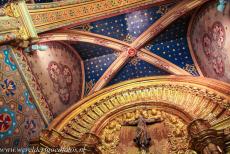
Mudéjar Architecture of Aragon: One of the side chapels of the San Pedro Church in Teruel. The vault of the San Pedro is adorned with golden stars over a blue background. The interior of the church was adorned in the Neo-Mudéjar style in the period1896-1902. The bodies of the Lovers of Teruel were exhumed beneath the floor of one of the side chapels of the San Pedro Church in 1555. Their new tombs were placed in a mausoleum next to the church.
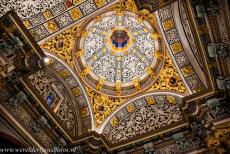
Mudéjar Architecture of Aragon: The dome of the mausoleum in the San Pedro Church, Teruel. The San Pedro Church was built in the Mudéjar style. Mudéjar is the name given to muslims of Al-Andalus who remained on the Iberian Peninsula after the Reconquista in 1492. The Mudéjar had great influence on the architecture in Portugal and Spain, especially of Aragon and Castile. The Mudéjar Architecture of Aragon was inscribed on the UNESCO World Heritage List in 1986.
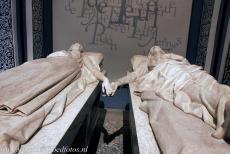
Mudéjar Architecture of Aragon: The San Pedro Church in Teruel houses a mausoleum with the remains of the Los Amantes de Teruel, the Lovers of Teruel, Isabel de Segura and Juan Diego de Marcilla. The story of the Lovers of Teruel ended tragically. The tragic story is supposed to have taken place in 1217. The marble tombs were sculpted by Juan de Ávalos. The hands of the lovers do not actually touch because Isabel was married to another man.
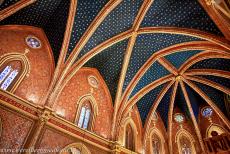
Mudéjar Architecture of Aragon: The decorated ceiling of the San Pedro Church in Teruel. The exterior of the brick San Pedro Church is adorned with tilework, plaster carving, wood carving and ornamental metals. The Gothic ribbed vault ceiling of the church is decorated with golden stars over a dark night blue background. The Mudéjar architecture is the result from Muslim and Christian cultures living side by side in Spain.
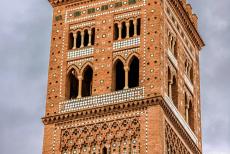
Mudéjar Architecture of Aragon: The Torre de El Salvador was built in the beginning of the 14th century. The 40 metres tall bell tower is one of the most outstanding Mudéjar towers in Teruel. Buildings in Mudéjar style can be seen only on the Iberian peninsula. The Mudéjar style reached his peak in the city of Teruel. A large number of imposing churches and towers in the Mudéjar style were built in Teruel during the 13th, 14th and 15th centuries.
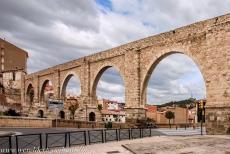
The Los Arcos aqueduct and viaduct in Teruel was built in the 16th century, it is also known as the French aqueduct. The aqueduct is carried by a series of stone masonry arches and has two storeys. Los Arcos Aqueduct crosses the divide between medieval Teruel and modern Teruel, it carried both water and people across a valley. Los Arcos does not belong to the UNESCO World Heritage Site Mudéjar Architecture of Aragon, but the aqueduct is interesting to visit.
